CEP-KAS: Sahel Monitoring April 2023

This fifth monthly analytical report based on open source observations of Jihadi activities throughout the Sahel will focus on the most significant events that occurred in April 2023. The month of April partly overlapped with the holy month of Ramadan (March 23 – April 20).
During Ramadan, there is generally a steep rise in operations by Jihadi groups worldwide. This year, however, the Ramadan campaign reached results that were far from impressive. In the heartlands of the so-called Islamic State (IS) in Syria and Iraq only a limited number of attacks occurred during Ramadan, with 15 attacks in March and 36 in April. These are less than a third of the attacks claimed in Ramadan 2022 and amount to just 14.8 percent of attacks that occurred during Ramadan in 2020. This trend is visible, not only in the heartlands of IS but indeed throughout the majority of its worldwide Wilayat (provinces).
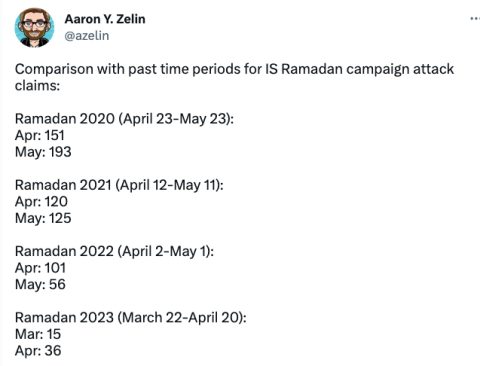
Attacks in the Sahel – General Trends
In the Sahel, however, the situation is different. Although IS and its affiliates in the region did not officially announce a global Ramadan terror campaign this year via its social media channels, there was still a slight increase in the number of claimed attacks during this time. In March the number of claims rose from 41 to 52, while claims in April rose to a total of 68—an increase of almost a third. Therefore, rather than an unofficial Ramadan campaign, the increased attacks are part of a continuing trend of a rising insurgency throughout the Sahel, indicating that regional destabilization persists unabated.
Terror attacks by al-Qaeda’s branch Jama’a Nusrat ul-Islam wa al-Muslimin’ (JNIM) and IS’s two branches—the Islamic State in Western Africa Province (ISWAP) and the Islamic State in the Sahel Province (ISSP, a.k.a. the Islamic State in the Greater Sahel or ISGS)—all continued to increase during the past month. The Sahel is becoming a quagmire that is slowly draining most regional governments’ resources and capabilities. Several areas are slowly replaced by either Jihadi groups, bandits, or Wagner Group forces as the main power broker. In an exclusive interview with Wassim Nasr for France24, Abu Obeida Youssef al-Aanabi, the current leader of al Qaeda in the Islamic Maghreb (AQIM), described the Sahel as the “epicentre” of current “Jihad.”
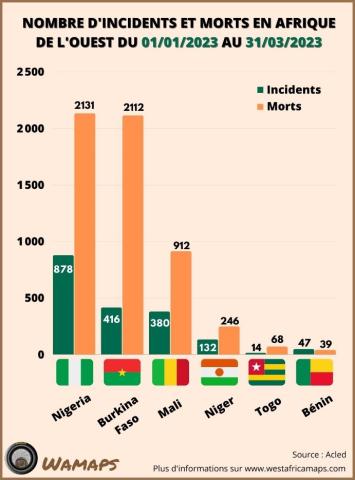
(Source: https://twitter.com/Wamaps_news/status/1644270838684823553?s=20)
During the reporting period, the following attacks were carried out:
Table 1: Attacks Claimed During Ramadan (March 23 – April 20)
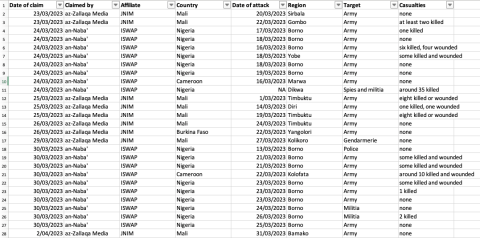
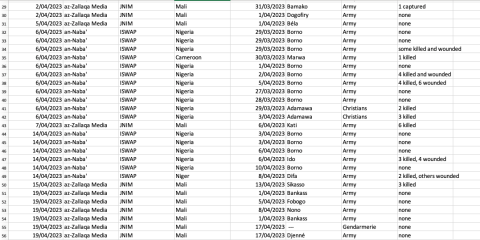

It is remarkable that during the Ramadan period, not a single claim was posted in the name of ISGS / ISSP.
Forty-eight of the 70 claimed operations during Ramadan are from ISWAP, with the overall majority being relatively small-scale attacks in Nigeria (41). However, there is one exception of an attack in Dikwa in which approximately 35 individuals, labeled as “spies” and “militia-members” by ISWAP, were reportedly killed.
Four attacks were claimed by ISWAP in Niger and three in Cameroon.
Twenty-two attacks (also relatively small scale) were claimed by JNIM. The majority of these operations were carried out in Mali (19), and only three were attributed by the group to actions in Burkina Faso.
This statistic demonstrates that the region did not experience a significant increase in terror operations associated with Ramadan campaigns by IS-affiliates and JNIM in previous years. For comparison, below are the number of IS attacks during Ramadan since 2020, as documented by French researcher Damien Ferré.
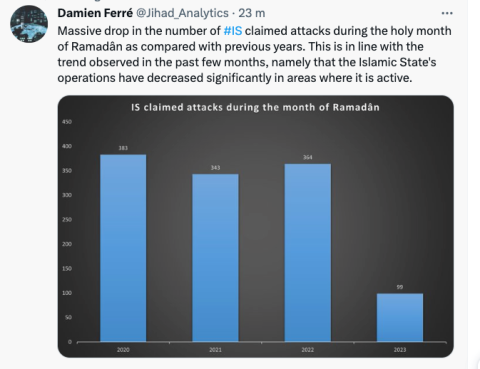
However, the continuing trend of monthly increases in terrorist operations in the region that is visible between the end of March and the end of April is part of larger, long-term strategic operations by these terror groups. Their aim seems to be to grow their operational intensity and continue to further destabilize the region.
Attacks Per Country
- Nigeria experienced the highest number of attacks during the reporting period. Thirty-nine out of a total of 68 claimed attacks in the region affected targets within Nigeria. The majority of the claims refer to attacks in Borno province. Generally, the attacks were of relatively low impact. Exceptions are claimed attacks in Adamawa, Kirinowa, and Jigawa. In Adamawa and Jigawa, the attacks targeted the local Christian population and reportedly killed 11 individuals. All attacks were claimed by ISWAP.
- In Mali, 17 attacks were claimed by JNIM. Most of these attacks were smaller scale. However, two of the claimed attacks targeted high profile targets. On April 18, Malian Chief of Staff Oumar Traore was killed in an ambush. On April 22, JNIM attacked the airport of Sévare and the International Airport of Mopti Ambodédjo, where, according to media reports, several Wagner Group fighters were based.
- In Burkina Faso, JNIM claimed five attacks on the Burkinabe army. None of those were of any significant scale. Despite continued terrorist violence, some civilians are now reportedly more afraid of Burkina Faso’s security forces. They have been accused by the local population of extrajudicial killings and forced disappearances of a significant number of individuals that the security forces claimed were supporters of terrorist groups. Given the diminishing trust of the population in its security forces and the increase in terrorist operations, it seems likely that the Wagner Group will fill this widening security gap.
- In Niger, ISWAP claimed responsibility for five attacks. Sixteen Nigerien soldiers were allegedly killed and at least 10 wounded; two others were captured.
- In Cameroon, two attacks were claimed by ISWAP, which allegedly left 11 soldiers dead.
Table 2: Total Number of Attacks
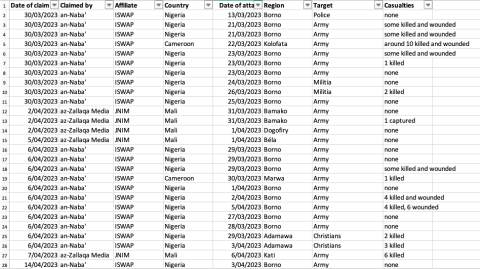
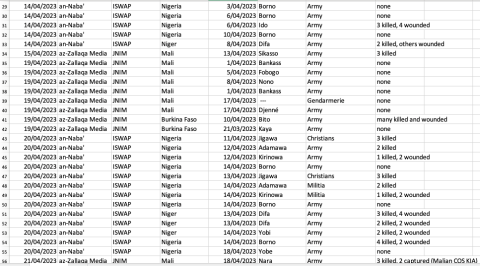

Attacks Per Affiliate:
ISWAP
ISWAP claimed the overall majority of attacks in the region during the reporting period. In total, 46 operations were claimed by ISWAP in Nigeria, Niger, and Cameroon. Most of these attacks targeted army forces and militia in the Borno area. A few sporadic attacks were aimed at the Christian population in the Adamawa and Jigawa areas. The overall impact of these attacks is relatively low with a maximum of eight reported kills in a single operation.
Table 3: Total Number of Attacks Claimed by ISWAP
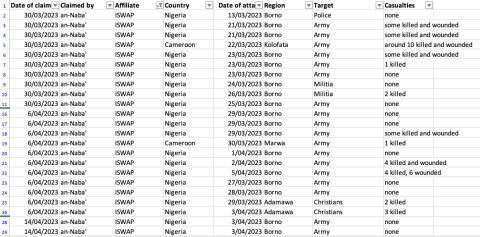
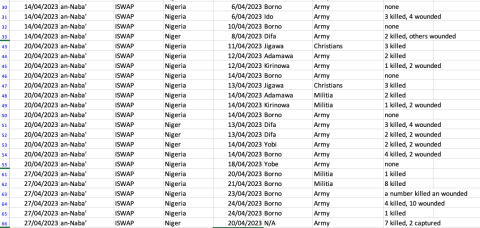
ISGS/ISSP
No attacks were claimed by ISGS/ISSP.
JNIM
Al-Qaeda’s affiliate JNIM claimed 22 attacks, all of which occurred in Mali. The most significant attacks were the killing of the Malian chief of staff on April 18 and a large-scale operation targeting the airport of Sévare, where JNIM claimed to have killed dozens of Malian soldiers and Wagner Group mercenaries.
Table 4: Total Number of Attacks Claimed by JNIM
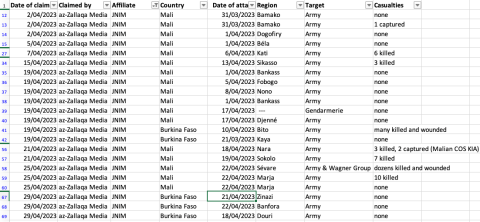
Conclusion
While it appears that there was no official Ramadan campaign this year, the number of terrorist operations throughout the Sahel continued to increase. This trend is clearly discernible even though the daily monitoring of these attacks for this project began in December 2022. This ever-increasing regional destabilization presents a growing challenge not only for local authorities but also for the wider region. The ambitions of JNIM, ISWAP, and ISGS/ISSP are not geographically limited. Therefore, if the region completely destabilizes, there will be spill-over effects for the wider African continent and towards the European Union.
Table 5: Claimed Attacks, December 2022 – April 2023
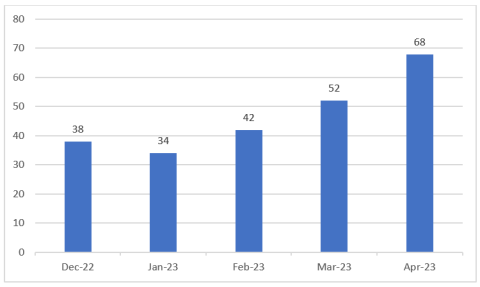
Table 6: Claimed Attacks, December 2022 – April 2023 (per group)
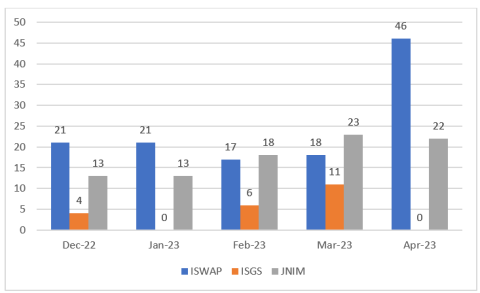
Table 7: Claimed Attacks, December 2022 – April 2023 (per country)
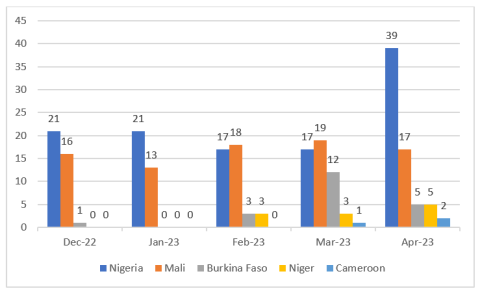
Although almost all of these terrorist operations were of relatively small-scale, the trend is persistent. Nigeria remains to be the most targeted country in the region, as ISWAP claims operations there on an almost daily basis. The majority of claimed attacks in April were indeed claimed by ISWAP, with 46 operations were claimed in Nigeria, Niger, and Cameroon.
Twenty-two attacks were claimed by al-Qaeda’s affiliate JNIM. Mali remains the core area of JNIM operations. Among these, the most significant operations were the killing of the Malian chief of staff on April 18 and a large-scale operation on the airport of Sévare, targeting the Malian army and Wagner Group forces.
The situation in the Sahel seems to be deteriorating from month to month. Western forces are retreating from the quagmire. As of May 3, German troops in Mali, operating under command of MINUSMA, began withdrawing. France’s withdrawal and the reduction of their activities in the region means that the resulting security vacuum will be filled either by terrorist entities, Wagner, or in some areas, both. The Sahel remains a powder keg, and the fuse seems to have been lit—and the full impact has yet to be realized.

The Counter Extremism Project Presents
Enduring Music: Compositions from the Holocaust
Marking International Holocaust Remembrance Day, the Counter Extremism Project's ARCHER at House 88 presents a landmark concert of music composed in ghettos and death camps, performed in defiance of resurgent antisemitism. Curated with world renowned composer, conductor, and musicologist Francesco Lotoro, the program restores classical, folk, and popular works, many written on scraps of paper or recalled from memory, to public consciousness. Featuring world and U.S. premieres from Lotoro's archive, this concert honors a repertoire that endured against unimaginable evil.